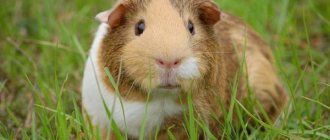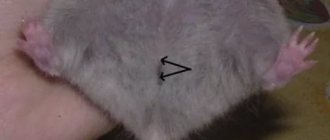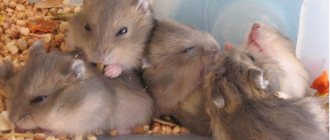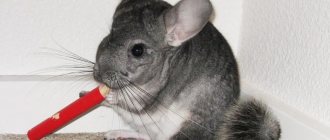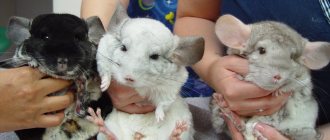Many novice farmers, having read reviews from experienced livestock breeders on the Internet, decide to breed chinchillas at home. And they are convinced from their own experience that this activity does not require a lot of time and money, as well as special skills. From the article you will learn how to breed chinchillas at home, what is needed for this, what conditions need to be created on a mini-farm.
Purchase of chinchillas and equipment
Purchasing chinchillas. What affects the cost
The cost of an animal is influenced by many factors:
- age;
- floor;
- dimensions;
- color;
- hair quality;
- health status.
The most profitable purchase will be a male aged from 3 to 6 months with a normal color. A female from the same litter will cost more. Breeding chinchillas at home requires the presence of at least 10 females and 2 males. It is not necessary to purchase males, since many existing farms can provide their inseminators for temporary use.
How to choose chinchillas
- Individuals must reach two months of age; it is not recommended to separate the cubs from their mother earlier.
- The optimal weight for babies at this age is 200 grams.
- The fur of a healthy animal is clean. If there is dirt under the tail, then the animal may have gastrointestinal disorders.
- There should be no pus or light spots on the animal’s eyes; the eyes of a healthy chinchilla are clear.
- During children's games, the pet could lose a phalanx of a finger, a piece of an ear, or receive another minor injury. These shortcomings are more of an aesthetic nature.
- You should make sure that the rodent is not sick with lichen. To do this, just check the skin for redness in the area of the nose, eyes, chin, ears, groin, base of the tail and front paws.
- The absence of fur patches is not a serious deviation. The fur will quickly recover.
- Ideally, you need to find out the color of the parents of the purchased individual. If the breeder has a pedigree for offspring, that's even better.
Pairing
Chinchillas are nocturnal animals. Therefore, their mating process usually occurs at night. With the onset of estrus, the boy shows active courtship towards the female. And when she succumbs to his charms, he jumps on her, biting the fur on her back. After which the actual sexual intercourse occurs. It does not last long - only a few seconds.
Not every owner will sit in front of the cage all night long to make sure the event is successful. In addition, this will greatly stress the animals. The fact that everything went well for them can be judged in the morning by the fur and dried sperm of the male scattered throughout the cage.
Purchase of equipment
Cells
Cages will be required to house the animals. A number of requirements must be applied to them:
- Optimal sizes are 50/50/60 cm.
- Using fine mesh.
- An area of at least 0.3 sq.m per head.
- Durable material, steel will do.
- Safety.
- Ease of cleaning.
- Many experienced breeders arrange the cages in 2 rows of 6 cages. For this you need 18 sq. m from the area of the room.
Drinkers, feeders, senitsa
A mounted drinker is preferable. If you purchase a floor-mounted one, it must be heavy enough so that the animal cannot turn the vessel over.
The best option is a wire hay barn, from which it is convenient for the rodent to get grass without scattering food on the floor.
For chinchillas, it is recommended to use drinkers with a nipple system. Such a device will provide a round-the-clock supply of clean water to the animals and will not allow them to wet the bedding by splashing the liquid.
Sun lounger, house
The pet bed is usually placed on the back wall. The width of the lounger is at least 12 cm. Height from the floor is 25 cm.
The pet should have a place for privacy in the form of a cozy house. It is made without a bottom from rodent-safe wood species.
Pallet and litter
A tray with filler is installed on the floor. Sawdust, hay, shavings can act as filler. The litter should be replaced at least 2 times a week.
Bathing suit
Raising chinchilla livestock is impossible without a bathing bath - this is a container with volcanic sand for taking baths and cleaning the hair of the fur skins.
Animals are not bathed in water; sand helps keep them clean. The bathing suit should be spacious and have closed sides.
Toys, dental trainers
A running wheel, a walking ball, tunnels and everything that can be chewed with benefit for the teeth. Mineral stone is also used for grinding teeth
mineral stone required. You can use salt stones, chalk and pumice. The pet store has a wide range of entertainment for rodents. And there is a lot of information on the Internet about how to make toys from scrap materials.
Cleaning and disinfection products
Disinfection is carried out using special non-toxic agents or an ultraviolet lamp. During cleaning and disinfection, it is better to let the animals go for a walk or move them to a temporary home.
Other devices
To maintain the indoor microclimate you will also need:
- convectors for heating and maintaining optimal air humidity;
- 60 W lamps (1 piece per 10 sq.m.);
- air conditioner.
Formation of a couple
Before mating, you need to select a pair, paying attention to the following points:
- the animals must match each other according to breeding data;
- have good pedigrees;
- have good health;
- have similar color and quality of fur;
- the couple should not consist of close relatives up to the third generation of kinship.
When forming couples, it is also necessary to take into account the age of the partners. Females reach sexual maturity at 6-9 months. It is advisable to choose a male that is 2-3 months older for her. If the female is older than a year, on the contrary, it is recommended to choose a male 2-3 months younger for her. But this condition is not mandatory.
To give birth to viable offspring, the female and male must be in excellent physical shape. You need to know that emaciated or, on the contrary, obese animals can produce sick or weakened puppies. It is quite possible that the female will not become pregnant at all.
Before mating, you should determine the relationship of the partners to each other. To do this, they are first placed in different cages, but placed at a close distance. This way the animals will be able to get somewhat used to each other. Then an attempt is made to place the couple together. If a calm relationship has been established between the animals, they do not quarrel or fight, then the replanting was successful.
Females are generally larger, stronger and more aggressive than males. If there is no peaceful life between the animals, on the contrary, there is aggression, then the failed pair should be separated and other options for mating should be selected.
Chinchillas recognize each other by smell, and if one animal has already been living in a cage for some time, then it may try to drive the newcomer out of it. If this happens, there are several ways to reduce the old-timer's aggressiveness. For example, placing a cage with a new animal next to an old cage. In 2-3 days, the animals will get used to each other’s smell, after which you can try to place them together, and if unsuccessful, place them again, changing places. After a few days, you can try again.
You can try placing a small (transport) cage with a newcomer inside a large cage with an old resident for 4-5 hours. The animals will make contact, but will not be able to fight.
A successful option may be to lock the old resident for 3-4 hours in a small cage located inside the large one into which the newcomer is released. The latter, moving freely, will leave its smell in all corners of the cage and accustom the “owner” to it. When the old-timer is finally released from the small cage, he will treat the newcomer with “respect.”
Usually fewer problems arise when forming a pair of young individuals. Animals most easily get used to each other at the age of six months, immediately after reaching sexual maturity, and they can be used for breeding until they reach the age of ten.
The time for active mating of animals in natural conditions is from November to May, in captivity – from November to April. By changing the behavior of animals, one can determine their readiness to reproduce. The male begins to actively court the female, running after her around the cage, snorting loudly, and wagging his tail. The female is restless, eats poorly, and scatters food around the cage. All these signs indicate that the couple has formed, and it will not delay the start of reproduction.
Chinchillas rut approximately every 40-41 days. This period can vary from 30 to 50 days. The duration of the rut is from two to seven days. The female accepts the male’s “signs of attention”; during estrus, she lifts up the back of her body and seems to stretch out in front of her suitor, indicating her readiness to mate.
Conditions for keeping chinchillas
Feeding
Food for chinchillas is divided into:
- Concentrated feeds: legumes and grains.
- Hay – cereals and meadow grasses.
- Grain – barley, corn, millet, wheat, etc.
In home breeding conditions, rodents are deprived of sunlight, so pets need to add foods rich in vitamin D to their food:
- bone flour;
- dried fruits;
- fortified hay;
- vegetable mixtures;
- dried greens.
Undesirable foods include seeds and nuts, which can cause obesity and gastrointestinal upset in animals due to their high fat content.
Products should be inspected for mold and debris.
Also, fresh, clean water at room temperature should always be freely available to animals.
It is recommended to organize the animal’s diet as follows:
- provide food in the evening;
- number of feedings per day – 1 or 2: 1 time with hay, 2 times with mixed feed;
- Give vitamins a couple of times a week: you can offer an apple.
Microclimate
The room in which chinchillas are located must meet the following requirements:
- Air humidity – 60%.
- Air temperature – from 12 to 20⁰С.
- No drafts.
- Clean and dry.
- No sharp or loud sounds.
- Scattered sunlight.
Care and cleaning
Once or twice a week, the cages are cleaned and the bedding is changed. The premises and equipment are disinfected monthly. All of the above procedures are recommended to be performed in the afternoon, when pets are most active. It is not advisable to touch animals while sleeping.
For chinchillas to take baths, a trough with sand is placed in their cages. The animals are very clean and “wash” every day. To care for the teeth of rodents, tree branches and mineral stones are placed in the home.
Kinds
Before you get a chinchilla at home, the first thing you need to do is decide on the breed, of which there are many. The most common are:
- Agouti;
- Foggy;
- Motley;
- White recessive and dominant;
- Pink and white;
- Beige breed and many others;
They all have some differences in their appearance, but they have one thing in common - the process of reproduction.
Rules for breeding chinchillas
There are a number of simple rules for beginning farmers:
- Three-month-old animals are placed in separate cages
- To catch an animal, you need to grab it by the tail or ear.
- Chinchillas need enough sand to keep their fur coat clean.
- When organizing a farm, sound insulation should be provided.
- Among rodents, inbreeding is prohibited.
- To obtain healthy offspring, it is sometimes necessary to replace old males with new ones.
- Mating before one year of age is undesirable.
- A pregnant female gains 50 grams every 2 weeks; to understand whether she is fertilized or not, it is enough to monitor the individual’s weight.
- Before giving birth, the male is separated from the expectant mother.
Hunting females
The hunting period of a female chinchilla has its own cycle, which consists of 40-41 days. On average, it lasts from 2 to 5 days.
It is not difficult to identify the moment when the hunt begins; just observe its behavior: the chinchilla begins to behave more actively, does not touch the food, and there is a complete mess in the cage (she throws everything out of it). In addition, there are a number of external signs that will help ensure the onset of sexual desire: swelling and slight hyperemia of the external genital organs.
Is it profitable to open a chinchilla farm - expert opinion
We have already talked a lot about the chinchilla business. But how do things work in practice? Let's find out from our good friend Andrey (31 years old), who has been raising and selling fluffy animals for more than three years.
“My business started, as they say, out of the blue. I used to just be into rodents, so I decided to buy a family of chinchillas as pets. I gave away the first offspring to relatives. It was they who suggested that I contact a pet store and negotiate the sale of subsequent litters. And now, for the fourth year now, I have been seriously studying these cute creatures. Now I sell them to restaurants and fur salons.
There were almost never any problems with the content. Sales have been established for a long time. True, I had to hire an assistant: since childhood I have not been able to watch animals being killed. Today, the funds from their sale not only cover all the needs of the farm, but also allow me to live comfortably,” Andrey shared.
Remember
- It is worth buying only breeding individuals.
- Before purchasing animals, create the conditions they need.
- Carefully study the composition of the feed, or better yet, prepare it yourself.
- Don't skimp on veterinarian services.
- Pay attention to advertising.
To reduce them to a minimum, create a detailed business plan or use ours. And remember - your own farm can please you not only with an abundance of beautiful fluffies, but also with a stable, ever-growing income!
(
3 ratings, average: 5.00 out of 5)
conclusions
Chinchilla fur occupies a strong place in the global fur market. But this is not a mass product, but an expensive exclusive product. Accordingly, those who buy it are very demanding on quality. This means that if you are planning to open a chinchilla breeding farm, you must first of all purchase expensive, preferably imported, breeding specimens. You will receive your breeding herd no earlier than in 2–3 years.
In addition, you need to rely on your own slaughter and sanding. It is not profitable to trade young animals. Finding buyers for a really good product will not be difficult. It is more difficult to produce high-quality products: it is about 1,000 identical good skins.
In Russia, the number of “chinchilla” enthusiasts is increasing every year, but so far there are few farms with more than 300 chinchillas. Most of them make ends meet by selling breeding animals, feed and related materials. Wholesale resellers make money mainly from fur.


